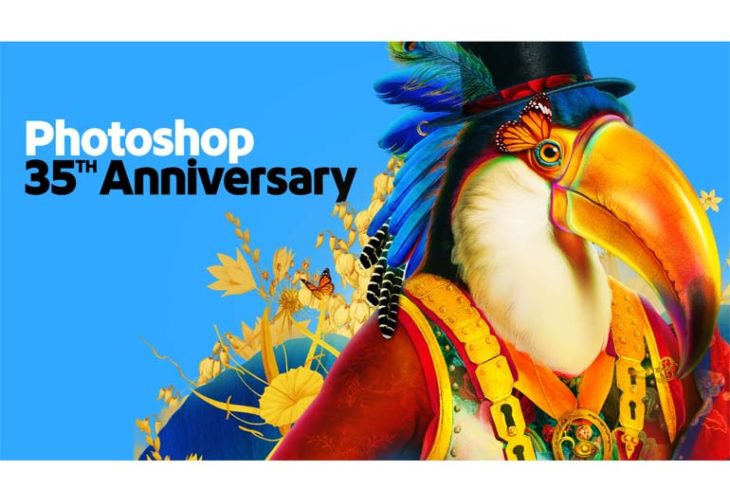
Adobe Photoshop Celebrates 35 Years of Creativity, Community, and Innovation
Adobe is proud to celebrate the 35th anniversary of Photoshop, the world’s leading digital imaging and design software that has transformed creativity across industries. Since its launch in 1990, Photoshop has empowered designers, photographers, and artists worldwide to bring their visions to life, shaping the future of digital art, visual storytelling, and creative workflows.
A Journey Through Decades of Innovation
1990: The Birth of Photoshop
In 1990, Adobe Photoshop was born, enabling the first wave of photographers to create with more tools and controls than ever before. Photoshop was introduced by Thomas and John Knoll to provide powerful digital image editing tools to edit and enhance photographs. What started as a niche tool for editing scanned images soon became an essential part of creative workflows.
1989-91: Photoshop Enters Hollywood
Before its official launch, an early version of Photoshop was used in the visual effects of The Abyss (1989). Co-creator John Knoll, who worked as a visual effects supervisor on the film, utilized Photoshop to help craft the groundbreaking water pseudopod sequence. This marked Photoshop’s first venture into Hollywood, paving the way for its major role in Terminator 2: Judgment Day just a few years later. Photoshop’s advanced features, like layers (introduced in 1994) and non-destructive editing, offered filmmakers unprecedented control over visual effects and post-production work.
1994: Layers Revolutionize Digital Design
Photoshop 3.0 introduced Layers, a game-changing feature that allowed users to separate and manipulate different elements of an image independently. This single innovation set a new precedent for digital design workflows.
1995: Non-Destructive Editing becomes the standard
The introduction of Adjustment Layers, Blend Modes, and Layer Masks transformed how artists edited images, enabling them to make changes to color, brightness, and contrast without altering the original image.
1998-9: A Household Name
The release of Photoshop 5.0 in 1998, which introduced the History Panel and Layer Effects, marked a turning point in mainstream adoption. These features made complex edits more accessible, fueling Photoshop’s widespread use in advertising, print media, and emerging online content. By the late ‘90s, Photoshop had established itself as a widely recognized tool in both professional and creative spaces, shaping digital imagery and pop culture alike.
Evolution through the 2000s
2001: Liquify Filter Launches
The Liquify Filter became a favorite among designers and photographers, enabling surreal distortions and precision retouching with ease.
2002: The Healing Brush Tool
This tool revolutionized photo retouching by seamlessly blending image textures, allowing imperfections to vanish instantly. This brush has been a game-changer for photographers and retouchers ever since.
2003: The Creative Suite Era and Adobe Camera Raw
Photoshop became part of Adobe Creative Suite, integrating seamlessly with tools like Illustrator and InDesign to enhance creative workflows. Additionally, the introduction of Adobe Camera Raw allowed photographers to edit raw files directly in Photoshop, preserving image quality while streamlining the editing process.
2007: Adobe Photoshop Lightroom
Lightroom was launched and becomes an empowering image editing complement for photographers and Photoshop users to make high quality edits and content. A fun fact, by coincidence, Lightroom and Adobe Camera Raw also share Photoshop’s February 19th birthday — all three products were launched on that day in different years!
2010: Content-Aware Fill
Photoshop introduced Content-Aware Fill, empowering users to conceal or replace unwanted objects from images with unprecedented ease and intelligence. Our initial video announcing Content-Aware Fill was one of the first videos on YouTube to go viral!
2018: Photoshop Receives a Technical Oscar
The Academy of Motion Picture Arts and Sciences honored Photoshop with a Scientific and Engineering Award, recognizing its groundbreaking impact on digital filmmaking and visual effects.
2018: Select Subject Simplifies Complex Selections
Powered by machine learning, Select Subject allows users to make precise objects selections with a single click, saving time and effort in complex workflows.
2019: Photoshop on iPad
Photoshop brought its best-in-class technology to a tablet, giving creators untethered freedom and flexibility to create on the go.
2023: Photoshop on the web
Photoshop was reimagined for a web browser with a streamlined user experience, focused on empowering newer users with a more intuitive interface.
2023: Generative Fill and Adobe Firefly
The launch of Generative Fill powered by Adobe Firefly — a commercially safe generative imaging model — changed how we can express our creativity and accomplish our goals. Since that introduction, we’ve expanded our suite of powerful generative capabilities, enabling you to ideate rich concepts more quickly, accelerate productivity, and simplify complex tasks.
Looking ahead: 2025 and beyond
While it was fun to commemorate Photoshop’s 35th birthday and reflect on how far we’ve come, it’s more exciting to look forward and shape the future of creativity with you, our community. We remain committed to building products that empower you to create anything you can imagine. Your passion and feedback fuel product innovation, so we hope you’ll continue this journey with us. We encourage you to connect with fellow creators online AND offline:
- This week, February 19th, share your early Photoshop creations on Instagram and tag the @Photoshop handle so we can amplify what you share.
- Join us on April 24th at MAX London to hear about the newest innovations from Adobe and Photoshop.
- Connect with other creators on our Discord Community, read about the journeys of artists Bella Kotak and Holly Rose Stones, and get the latest updates about Photoshop’s cutting-edge capabilities.
